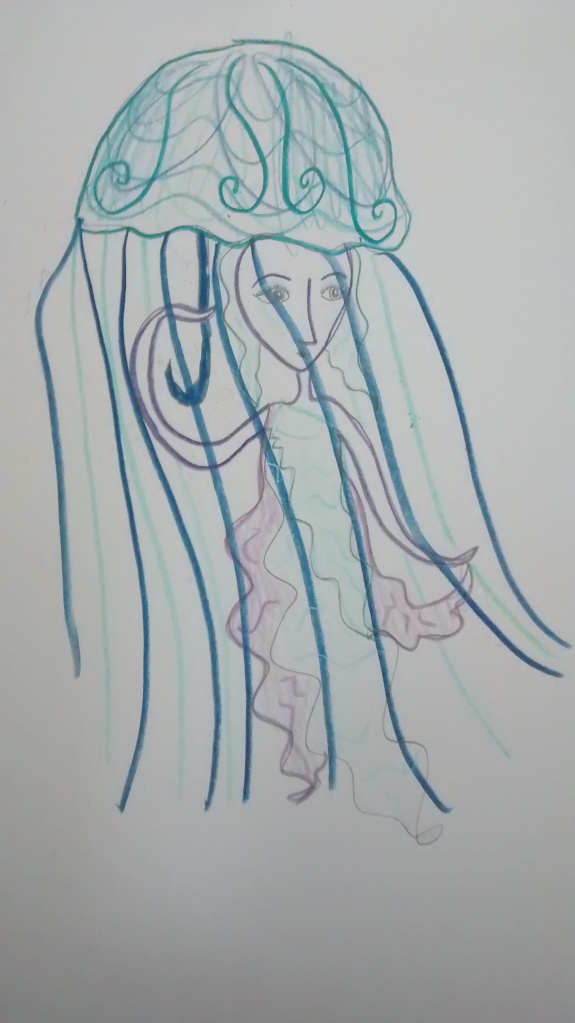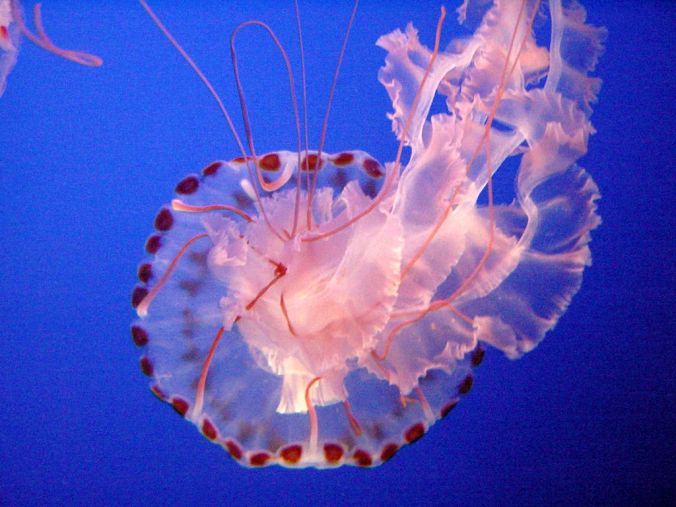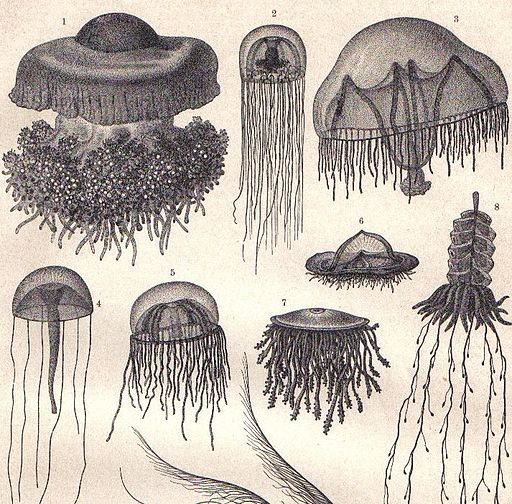The jellyfish in my right achilles heel have been studying astrology. My sign is somewhere in between the fallen elevator and the wild boar, apparently. But one of those is nearly extinct. Depending. Have you ever heard that song? It goes like: I sent you a letter last week and you still have not noticed that the sea is only paper dipped in molten denim until it’s a deep blue and smells like rust. There is also a rust-pipe peeking out your left ear but the tongue is somewhat slipshod. You had once a memory who tried to mend your ripped camisoles but you just ripped them too dang often so she left. In a parasol, to the sky. Do you even know the etymology of your own basement? The cellar will most likely refund your envy but not the jealousy which was not covered under contractable diseases. My love, I must confess to you now that my entire body is a pathogen.
sea jelly
Moon jellies
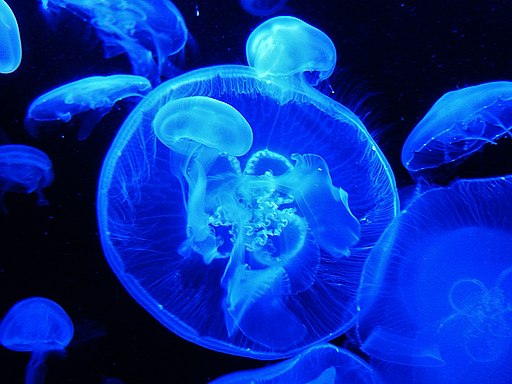
One half of a spun-glass planet,
in no hurry to find the other half…
Threads fray off edges, tickling darkness, catching the tiniest stars.
Soft tulips turned inside-out to midsummer gowns,
they winglessly fly through a watery sky
break light, without breaking,
trust truly, without eyes,
the sun-shawl that gentles them
anywhere in particular.
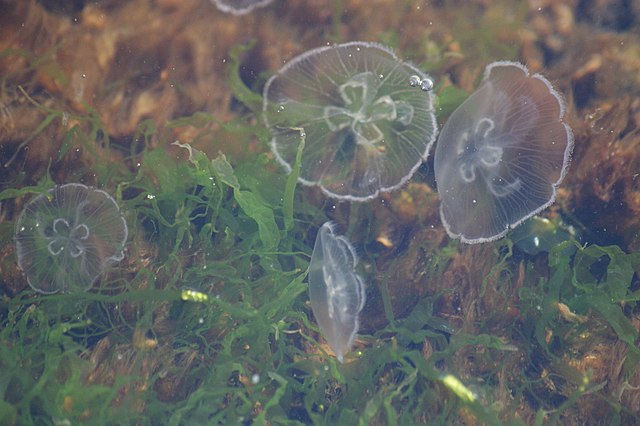
Image credits in order of appearance:
“Blue Jellyfish.” By Michael Coghlan [CC BY-SA 2.0 (https://creativecommons.org/licenses/by-sa/2.0)], via Wikimedia Commons
“Bruinisse – Kleine kwalletjes bij klein strandje.” By Rudolphous – Own work, CC BY-SA 4.0, https://commons.wikimedia.org/w/index.php?curid=63260266
Listening to Rock
Los niños beben al colegio para aprender cosas.

The boys drink at college to learn things. And who wouldn’t?
When you’re shut up in the dark ages
amidst jellylike teachers who comb the airless abyss for butterfly meat
in the dead pages
of a book which reads more intelligently backwards
and seasoned with toilet water,
in the dark
cages where the best years
of your life
fade blush and leap from the trees
with veins like open hands
and get crunched under your feet’s hurry to get to class —
Why wouldn’t you try to learn something,
anything, anywhere you can find it
just to enlighten the shutness?

Note: The first line of this poem comes from a Duolingo exercise in Spanish. I was supposed to be learning to say “the boys go to college/school to learn things,” but I find this answer more compelling.
Image credits in order of appearance:
By Symposium on the Physiology and Ultrastructure of Hydra and Some Other Coelenterates (1961 : Coral Gables, Fla.);Lenhoff, Howard M;Loomis, W. Farnsworth (William Farnsworth), 1914- – https://www.flickr.com/photos/internetarchivebookimages/20388622731/Source book page: https://archive.org/stream/biologyofhydraof00symp/#page/n38/mode/1up, No restrictions, https://commons.wikimedia.org/w/index.php?curid=42416137
“Ctenophore2.” Public Domain, https://commons.wikimedia.org/w/index.php?curid=709213
Chrysaora Romantica
Only one individual of this species has been recorded, inhabiting the northern Atlantic waters ranging from the Icelandic coast to that of Norway. Her parasol and dress seem to have become attached to her body and have developed nematocysts, allowing them to sting prey and predators alike.
No one knows for sure how this unique creature came to be. However, a compelling legend exists in Icelandic culture. According to oral tradition, a princess was betrothed to a prince who often abused his horse and caused his mother to shed tears. On the princess’ wedding day, she refused to kiss the prince, instead vaulting over the palace wall and running to the seashore. The angry prince pursued her into the sea, threatening to take her heart and soul in eternal matrimony regardless of her feelings for him. The sea witch, a misanthropist herself, took pity on the defenseless princess and dressed her in the tentacles of a recently dead sea jelly, giving her the creature’s bell as a shield. When the prince attempted to take the princess by the waist and sling her over his shoulder, he was in for a nasty surprise. Over the years, the princess learned to operate her new limbs and became a good friend of the sea witch. Now she patrols the seas, always looking out for any inhumane male sailors in need of a sting of reality.
A different story explaining Chrysaora Romantica was penned by a medieval Norwegian author whose works have been otherwise lost to the dusts of time. This story is still published in various editions in children’s books today, though most have snipped out all the unpleasant details of the original story so as to appeal to modern parents.
The original tale goes as follows: Once there was a girl named Blinda who wanted to marry Chrystophre, the most handsome young man in town. But Chrystophre preferred men. When Blinda caught sight of Chrystophre and his true love, a man, in passionate embrace on the edge of a sea cliff, she perceived the situation as a fight, and Chrystophre seemed to her to be in mortal danger. So she boldly ran toward the men and tried to assault the unknown one. To protect his love, Chrystophre instinctively pried the girl off of him. She was flung into the sea by the force of Chrystophre’s passion.
The icy water beat Blinda against the rocks, and her brain died instantly. But her heart lived on, and she swore to take revenge on the man who had broken it. Like a mindless zombie, she began to eat sea jellies, the stings not affecting her lifeless tongue. Eventually, she began to grow stinging tentacles of her own, and took to carrying a parasol bell for locomotion.
The following summer, when Chrystophre and his true love were swimming together in the shallows, Blinda realized they were in love. They looked so happy she couldn’t bear to sting either one of them, and began to cry with vicarious joy. For the first time in her life, her heart beat selflessly!
A moment later, a giant toothed whale deliberately beached itself in the shallows to devour the lovers. It tried to eat Blinda, but spit her out as her tentacles automatically scraped the sides of its mouth.
Blinda was now a sea jelly and could not die, try as she might. So she drifts aimlessly through the waters of the northern Atlantic to this day, hoping for death or love with equal fatalism.
Which story do you prefer?
The Chrysaora Conservation Society has begun researching Chrysaora Romantica. While so far their results are not finalized, there is speculation that the creature has the ability to reproduce asexually. If so, wayward sailors had better watch out for an army of angry stinging women on the high seas!
Image credits in order of appearance:
Drawing by Anne Seaworthy
“Eyjafjallajökull” by Andreas Tille – Own work: http://fam-tille.de/sparetime.htmlImage with Information in EnglishBild mit Informationen auf Deutsch. Licensed under CC BY-SA 3.0 via Wikimedia Commons – https://commons.wikimedia.org/wiki/File:Eyjafjallaj%C3%B6kull.jpeg#/media/File:Eyjafjallaj%C3%B6kull.jpeg
By Fred Hsu (Wikipedia:User:Fredhsu on en.wikipedia) (Photo taken and uploaded by user) [GFDL (http://www.gnu.org/copyleft/fdl.html) or CC-BY-SA-3.0 (http://creativecommons.org/licenses/by-sa/3.0/)%5D, via Wikimedia Commons
See page for author [Public domain], via Wikimedia Commons
